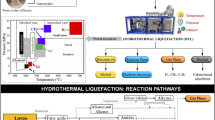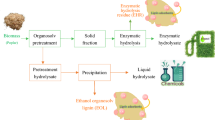Abstract
Biomass-based polyol obtained by chemical liquefaction technology is a potential substitute for polyether or polyester polyol in preparation of degradable polymers. To obtain the favorable biomass-based polyol products, one important emphasis is to reveal the liquefaction kinetics. The liquefaction kinetics of different corn stalk (CS) fractions, i.e. whole CS, ear husk and leaf blade, were investigated in this work. The liquefactions were catalyzed with sulfuric acid at 120–180 °C for 15–90 min. The results indicated that the apparent reaction rate constant (k), apparent activation energy (E), ΔG′, and ΔH′ of liquefaction reactions differed remarkably with different CS fractions. The highest k of 1.8 × 10−4 s−1 was obtained from ear husk liquefaction at 120 °C, which was twofold and 2.7-fold higher than those of whole CS and leaf blade, respectively. However, k is not correlated with the stalk heterogeneity at temperature over 120 °C. The calculated E ear husk, E whole CS and E leaf blade were 65.88, 81.64 and 85.23 kJ mol−1, respectively. ΔG′ and ΔH′ values of ear husk liquefaction reactions were lower than those of the other two fractions. This work was the first comparison of kinetics with different biomass fractions, casting light on the effect of heterogeneity on liquefaction, and suggesting that CS fractions should be given themselves optimum applications in future.



Similar content being viewed by others
References
Zamani A, Taherzadeh MJ (2012) Production of super absorbents from fungal chitosan. Iran Polym J 21:845–853
Wu W, Zhang J (2012) Preparation and characterization of environment friendly used rubber powder modified pulp sediments composites. Iran Polym J 21:763–769
Lee SH, Wang S (2005) Effect of water on wood liquefaction and the properties of phenolated wood. Holzforschung 59:628–634
Alma MH, Basturk MA (2006) Liquefaction of grapevine cane (Vitis vinisera L.) waste and its application to phenol–formaldehyde type adhesive. Ind Crop Prod 24:171–176
Chen FG, Lu ZM (2009) Liquefaction of wheat straw and preparation of rigid polyurethane foam from the liquefaction products. J Appl Polym Sci 111:508–516
Wang C, Pan JX, Li JH, Yang ZY (2008) Comparative studies of products produced from four different biomass samples via deoxy-liquefaction. Bioresour Technol 99:2778–2786
Nakamura A, Miyafuji H, Saka S (2010) Liquefaction behavior of Western red cedar and Japanese beech in the ionic liquid 1-ethyl-3-methylimidazolium chloride. Holzforschung 64:289–294
Hu SJ, Wan CX, Li YB (2012) Production and characterization of biopolyols and polyurethane foams from crude glycerol based liquefaction of soybean straw. Bioresour Technol 103:227–233
Kamio E, Takahashi S, Noda H, Fukuhara C, Okamur T (2008) Effect of heating rate on liquefaction of cellulose by hot compressed water. Chem Eng J 137:328–338
Ma JT (2012) In: China Statistical Yearbook 2012, Chap. 13, China Statistical Press, Beijing
Wang MC, Xu CB, Leitch M (2009) Liquefaction of corn stalk in hot-compressed phenol–water medium to phenolic feedstock for the synthesis of phenol–formaldehyde resin. Bioresour Technol 100:2305–2307
Wang MC, Leitch M, Xu CB (2009) Synthesis of phenolic resol resins using corn stalk-derived bio-oil produced by direct liquefaction in hot-compressed phenol–water. J Ind Eng Chem 15:870–875
Tymchyshyn M, Xu CB (2010) Liquefaction of bio-mass in hot-compressed water for the production of phenolic compounds. Bioresour Technol 101:2483–2490
Liu HM, Xie XA, Ren JL, Sun RC (2012) 8-Lump reaction pathways of corn stalk liquefaction in sub- and super-critical ethanol. Ind Crop Prod 35:250–256
Chen HZ, Li HQ, Liu LY (2011) The inhomogeneity of corn stover and its effects on bioconversion. Biomass Bioenerg 35:1940–1945
Pordesimo LO, Hames BR, Sokhansanj S, Edens WC (2005) Variation in corn stover composition and energy content with crop maturity. Biomass Bioenerg 28:366–374
Wang TP, Yin J, Zheng ZM (2012) Effects of chemical inhomogeneity of corn stalk on solvolysis liquefaction. Carbohyd Polym 87:2638–2641
Carrasco F, Roy C (1992) Kinetic study of dilute-acid pre hydrolysis of xylan-containing biomass. Wood Sci Technol 26:189–208
Küçük MM, Demirbas A (1999) Kinetic study on hydrolysis of biomass (Ailanthus altissima chips) by using alkaline-glycerol solution. Energy Conver Manag 40:1397–1403
Wang TP, Zhang LH, Li D, Yin J, Wu S, Mao ZH (2008) Mechanical properties of polyurethane foams prepared from liquefied corn stover with PAPI. Bioresour Technol 99:2265–2268
Lin L, Yao Y, Yoshioka M, Shiraishi N (1997) Liquefaction mechanism of lignin in the presence of phenol at elevated temperature without catalysts: studies on β-O-4 lignin model compound. I. Structural characterization of the reaction products. Holzforschung 51:316–324
Yamada T, Ono H (1999) Rapid liquefaction of lignocellulosic waste by using ethylene carbonate. Bioresour Technol 70:61–67
Yamada T, Ono H (2001) Characterization of the products resulting from ethylene glycol liquefaction of cellulose. J Wood Sci 47:458–464
Alma MH, Acemioglu B (2004) A kinetic study of sulfuric acid catalyzed liquefaction of wood into phenol. Chem Eng Commun 190:968–980
Acknowledgments
The authors are grateful for the financial support from the National Natural Science Foundation of China (grant#51306053), the Fundamental Research Funds for the Central Universities (grant#12MS39), and the National Scientific and Technological Support Plan (grant#2012BAA09B01).
Author information
Authors and Affiliations
Corresponding author
Rights and permissions
About this article
Cite this article
Wang, T., Yin, J., Liu, Y. et al. Differences in catalytic liquefaction kinetics of corn stalk fractions. Iran Polym J 22, 897–902 (2013). https://doi.org/10.1007/s13726-013-0189-4
Received:
Accepted:
Published:
Issue Date:
DOI: https://doi.org/10.1007/s13726-013-0189-4




